Physical Address
304 North Cardinal St.
Dorchester Center, MA 02124
The clinician should remember to “think skin” in patients with chronic eyelid/anterior segment ocular disease.
Patients with severe psoriasis may benefit from dedicated, interval eye exams.
Rosacea is often overlooked as an important cause of ocular disease.
Bioassays may become helpful in diagnosing and guiding treatment in rosacea and other dermatologic ocular diseases.
Specific causative genetic mutations continue to be discovered in many of these dermatologic diseases.
Immunomodulatory treatment continues to evolve as an important treatment modality for many of these disorders.
Dermatologic disorders often have manifestations involving the eyelids, conjunctiva, and cornea. Inflammatory and papulosquamous, immunobullous, genetic, and miscellaneous disorders are presented with attention to skin and ocular findings, histopathology, inheritance, etiology, and treatment.
Psoriasis is a common, chronic, recurrent, inflammatory disease characterized by well-demarcated, erythematous plaques covered by dry, silvery-white scales.
Psoriasis occurs with equal frequency in both sexes and affects 1%–2% of the population. Age of onset can range from infancy to the seventies, with a mean age of 27 years. Histopathologically, neutrophilic microabscesses are present on top of foci of parakeratosis, and there is thinning over the dermal papillae. Psoriasis is a hyperproliferative disorder, but the proliferation is driven by a complex cascade of inflammatory mediators. One-third of patients report a relative with the disease. The genetic inheritance is presumed to be multifactorial. Psoriasis is associated with a number of different human leukocyte antigen (HLA) haplotypes, especially -Cw6, -B57, -DR7, and -Cw2.
Typical lesions of psoriasis vulgaris occur on the scalp, nails, knees, shins, elbows, and gluteal cleft and are usually symmetrical. The course of the disease fluctuates, with a tendency to recur and persist. Removal of the psoriatic scale results in pinpoint bleeding sites (Auspitz sign). Lesions can occur at the site of mechanical trauma (Koebner phenomenon). Involvement may vary from mild to severe generalized disease. Spontaneous remission can occur.
Ocular signs may occur in up to 10% or more of patients with psoriasis. The periorbital skin, eyebrow, and eyelid can show typical scaly lesions ( Fig. 64.1 ). Blepharitis characterized by scaling, edema, erythema, trichiasis, or madarosis may be present. Ectropion, usually cicatricial, can occur. Conjunctivitis may result from the lid scales or from primary involvement of the conjunctiva with whitish-yellow plaque lesions. Corneal changes are less common and include peripheral infiltrates and vascularization, punctate epithelial keratopathy, erosions, superficial or deep opacities ( Fig. 64.2 ), and chronic ulceration and melting. Iritis occurs most often in the 6% of patients with psoriatic arthritis and may be clinically distinct from other types of anterior uveitis. Patients with severe psoriasis may benefit from dedicated, intermittent ocular examinations. Contrary to previous thinking, cataract risk is not increased in patients undergoing psoralen and ultraviolet A light therapy (PUVA) (psoralen photochemotherapy) who use eye protection.
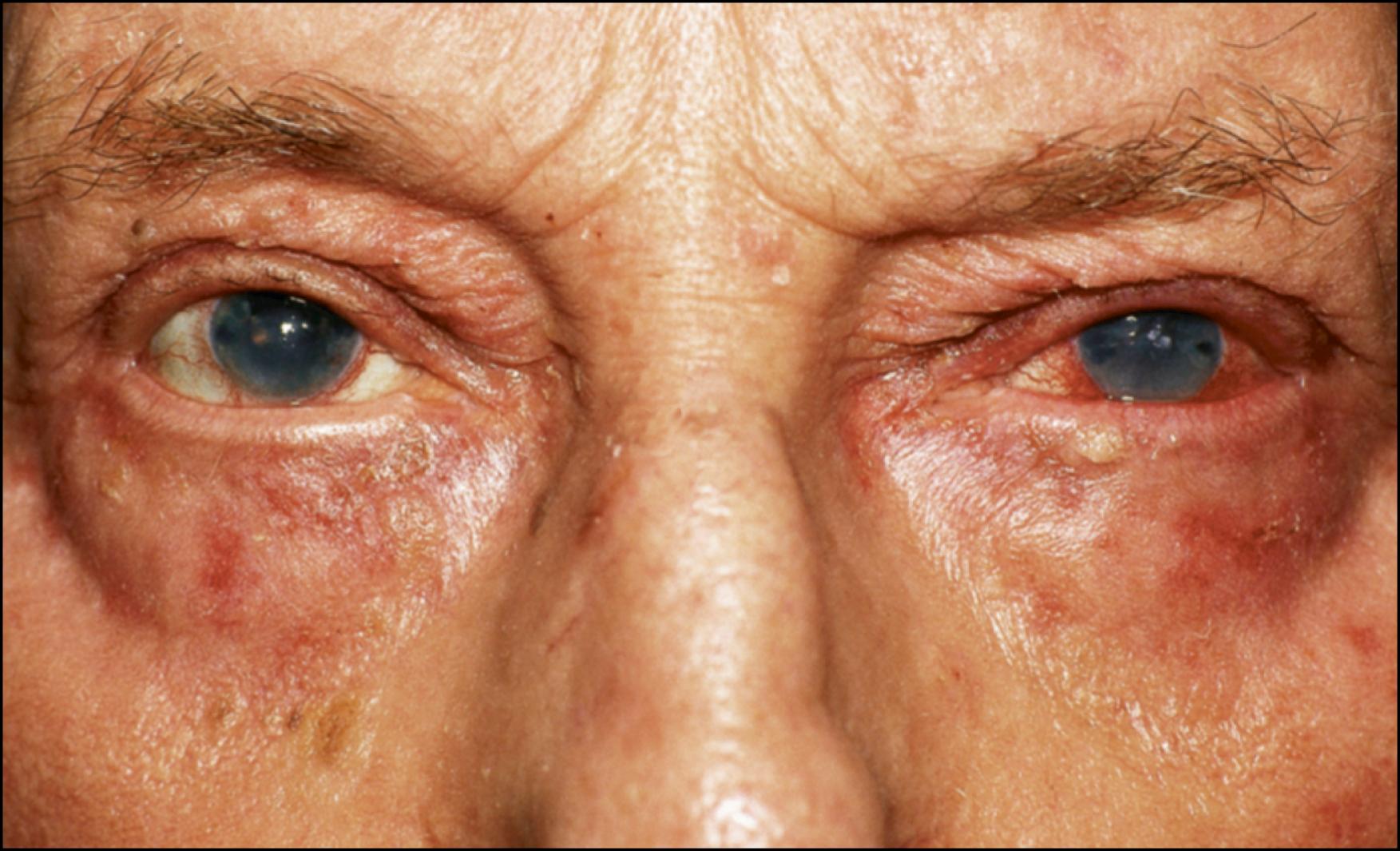
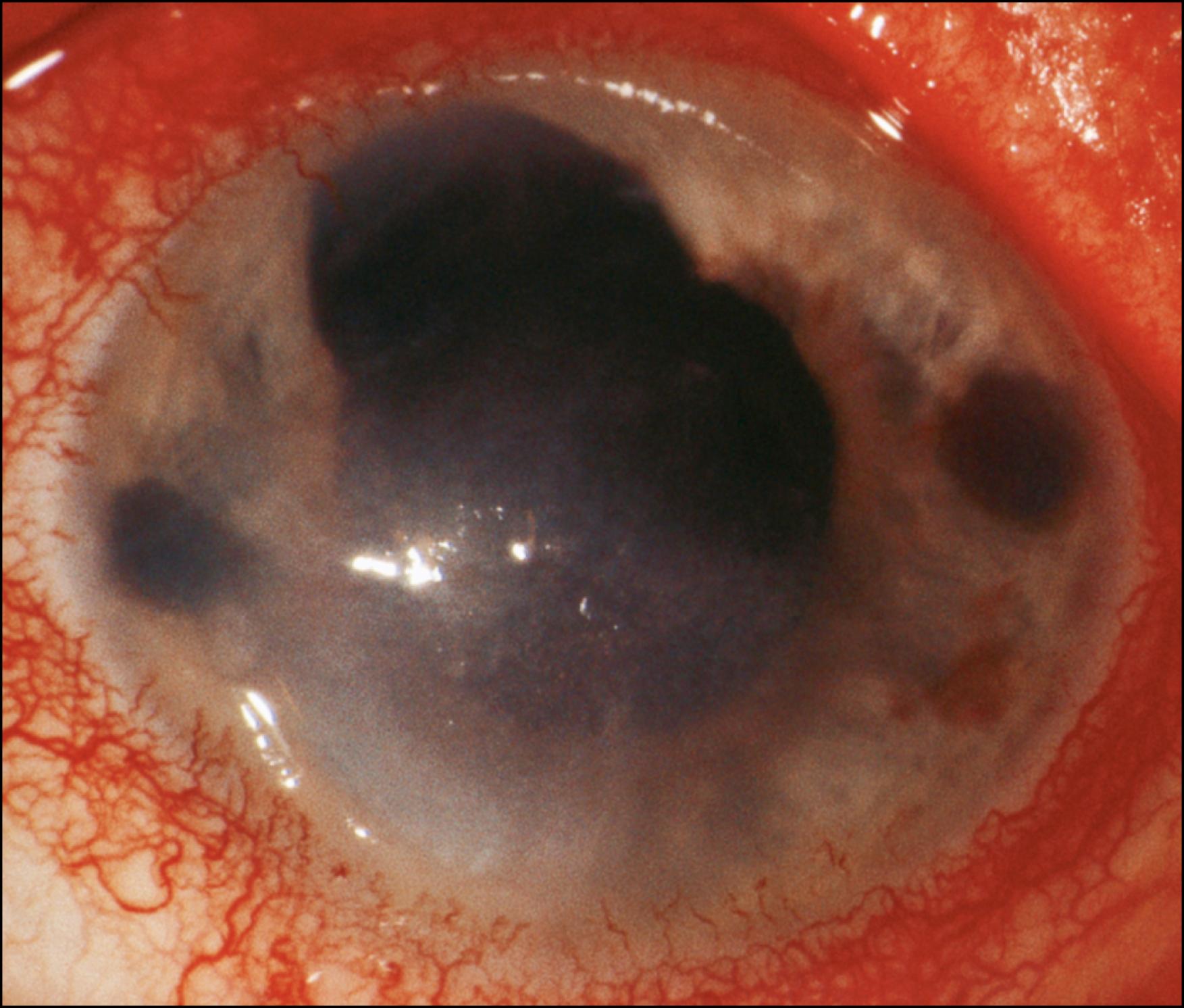
Treatment of skin lesions includes both topical and systemic modalities. Topical therapy includes skin hydration, glucocorticoids, calcineurin inhibitors, tar preparations, anthralin, tazarotene, and exposure to midrange ultraviolet radiation. Systemic therapies include oral retinoids, PUVA treatments, and, in severe psoriasis, methotrexate, cyclosporine, or bioimmunomodulators.
Ocular therapy is directed to the involved site: artificial tears, lubricating ointments, or topical cyclosporine for dry eye syndrome, hygiene for blepharitis, topical tazarotene for lid lesions, topical corticosteroid drops for conjunctivitis and iritis, cycloplegics and oral prednisone for severe iritis, and surgical repair of symptomatic ectropion. Biologic agents are increasingly proving beneficial.
Seborrheic dermatitis is a common, chronic, superficial inflammatory disorder characterized by oily scales and plaques on an erythematous base. The disease affects 2%–5% of the population. It is localized to sites containing large numbers of sebaceous glands, including the scalp, eyebrows, eyelids, glabella, nasolabial folds, retroauricular skin, external ear canal, chest, and back. The etiology is unknown, but hypersecretion of sebum may not actually be involved. A pathogenic role for Pityrosporum species has been postulated. Seborrheic blepharitis is very common in this disease and may be associated with ocular surface disease and dry eye.
Treatment of the dermatitis includes shampoos containing tar, zinc pyrithione or ketoconazole, topical corticosteroids, topical antifungal agents, and topical calcineurin inhibitors. Blepharitis is controlled with eyelid hygiene, intermittent topical antibiotic–steroid preparations, and ocular lubricants.
Rosacea is a common, chronic inflammatory eruption of the flush areas (forehead, nose, and cheeks) of the face. It occurs most commonly in middle-aged and older individuals and is more common in women than in men. Up to 10% of the population may demonstrate the disease. Four major clinical subtypes have been described: erythrotelangiectatic, papulopustular, glandular, and ocular rosacea. A patient-centered phenotypic approach has also been advocated. Rosacea is often overlooked as an important cause of ocular disease.
The facial skin lesions are characterized by erythema, papules, pustules, and telangiectasia. The onset is often subtle and generally becomes more severe with time. Although disease activity can wax and wane, spontaneous remission is rare. Patients with advanced rosacea, especially males, may develop rhinophyma. This process involves hypertrophy and hyperemia of the distal nose ( Fig. 64.3 ).
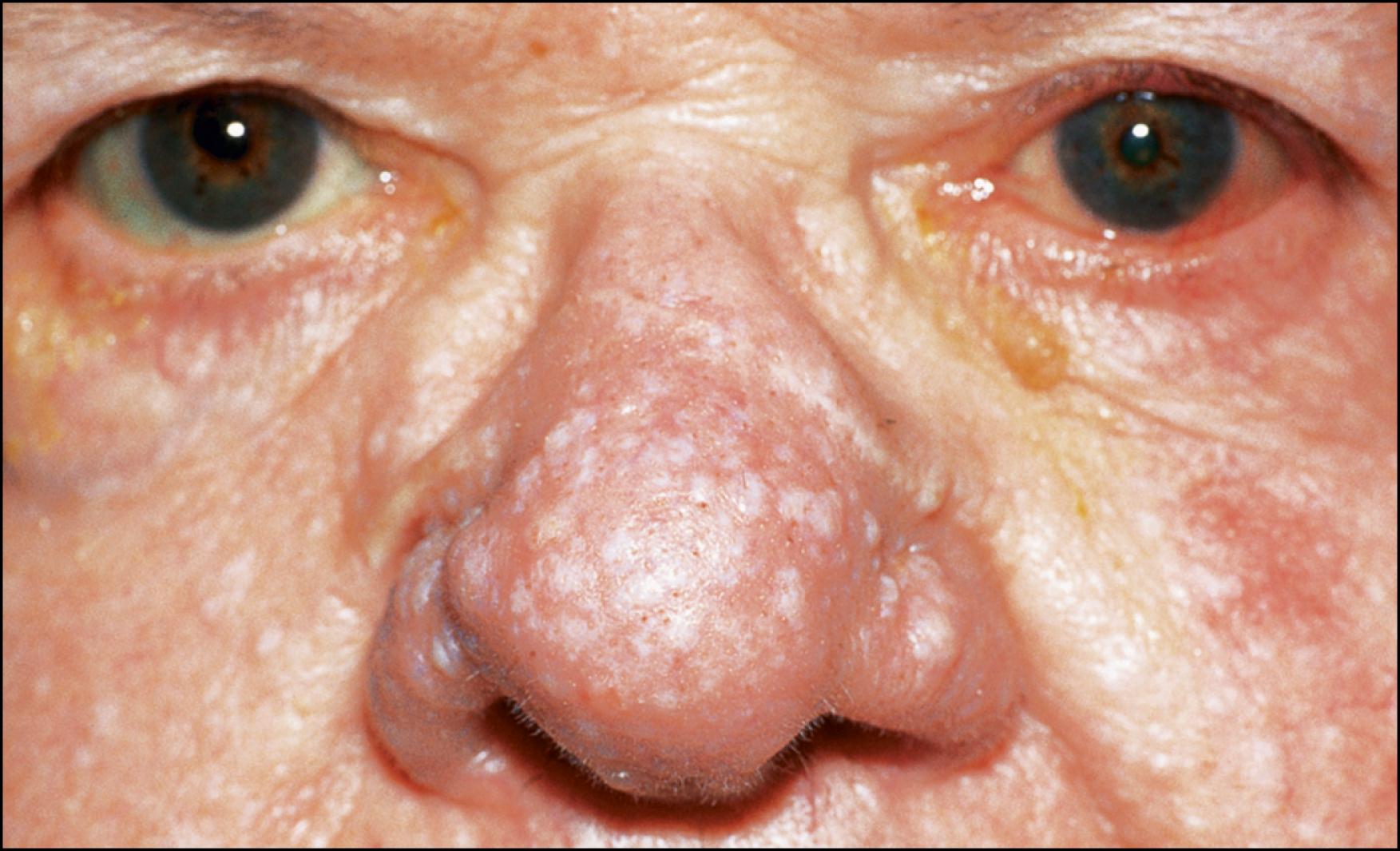
Ocular manifestations occur in about 50% of patients with rosacea at some point in the course of their disease. The severity of the ocular symptoms is often not related to the severity of cutaneous findings. Symptoms of ocular rosacea include burning, photophobia, and foreign body sensation. The lids, conjunctiva, cornea, and episclera may be involved. Blepharitis and meibomian dysfunction are the most common associated findings ( Fig. 64.4 ). Schirmer testing is frequently abnormal. The lid margins are hyperemic, thickened, and telangiectatic. The meibomian glands secrete excess sebum, and the orifices may be inspissated and inflamed. Chalazia and hordeola are common, and in some patients, staphylococcal lid infections can be demonstrated. Eyelid lymphedema has also been reported.
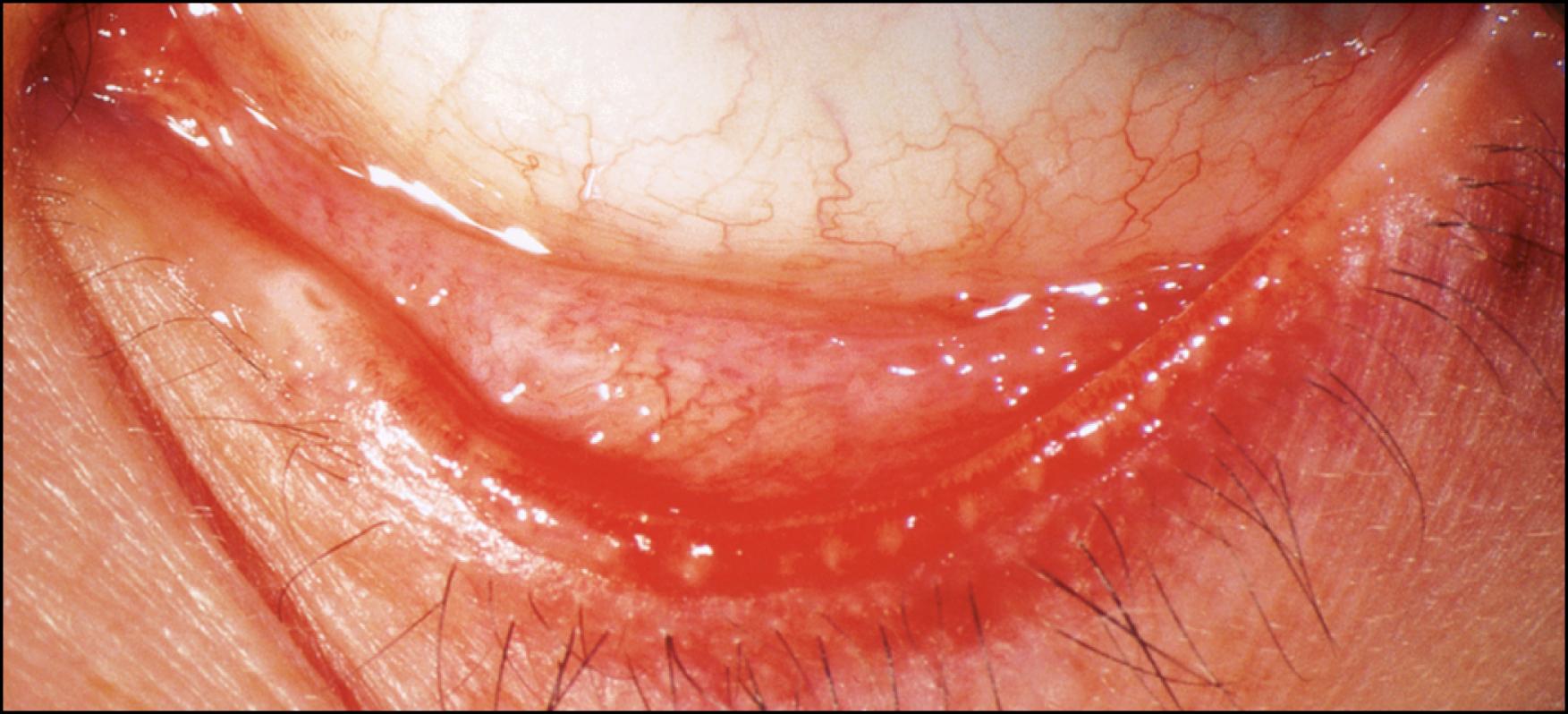
Chronic, diffuse conjunctival injection may occur, with vascular dilation and edema most prominently seen in the interpalpebral area. Less often, small, gray, vascularized nodules that resemble phlyctenules arise on the interpalpebral limbal conjunctiva.
Corneal involvement is seen in approximately 5%–30% of patients with cutaneous rosacea. , A superficial punctate keratopathy is common with meibomitis or blepharitis. A marginal vascular infiltration ( Fig. 64.5 ) can occur with vessels extending into grayish-white peripheral corneal tissue. As the keratitis progresses, subepithelial infiltrates may form at the leading edge of a leash of vessels. These lesions are more common inferiorly but can advance toward the central cornea. Ulceration and, rarely, perforation can occur. Chronic rosacea keratitis results in broad areas of pannus, usually inferior, “spade-shaped” peripheral scars, and stromal thinning.
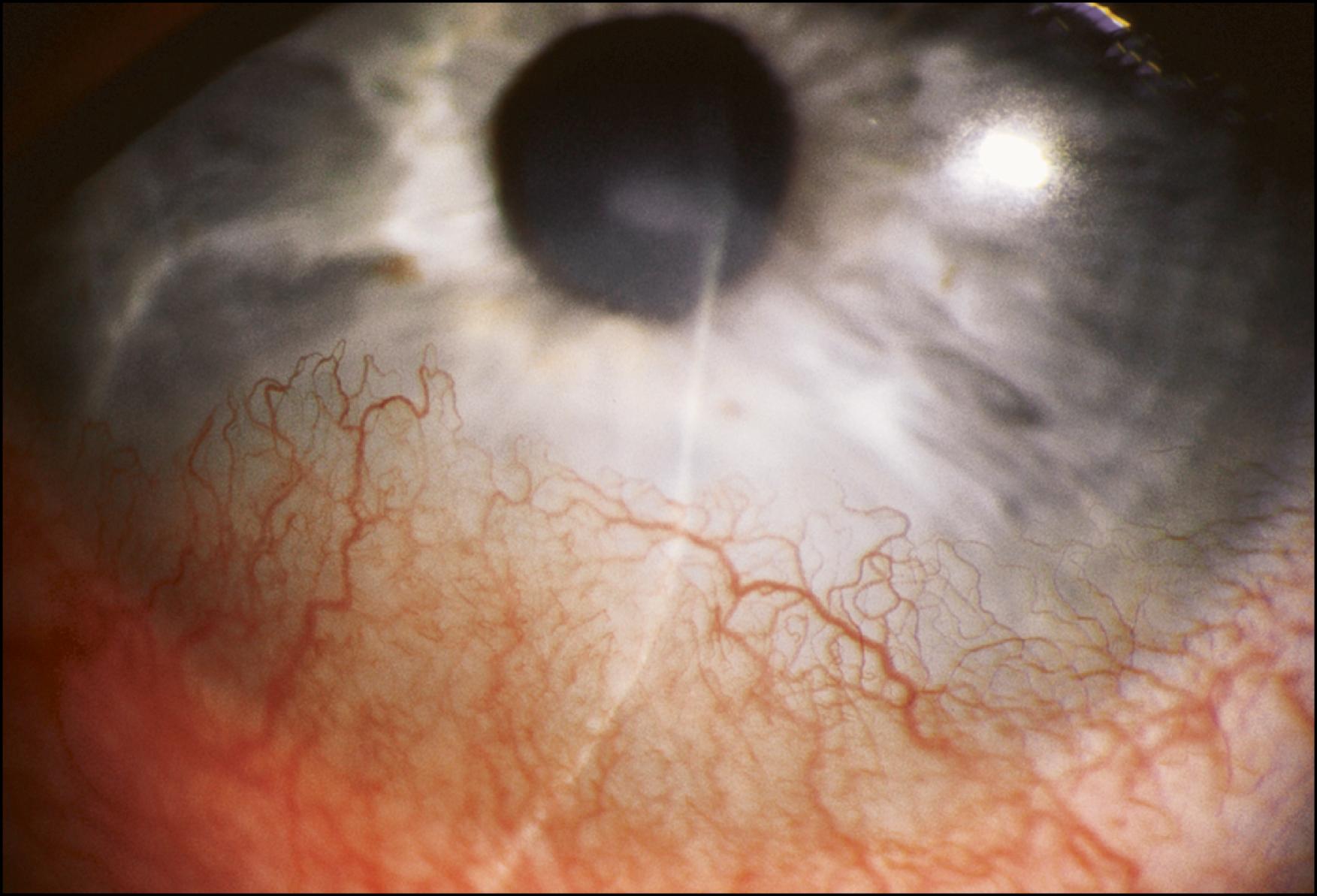
Nodular episcleritis, keratitis sicca, pseudokeratoconus, dendritic keratopathy, cicatrizing conjunctivitis, and bilateral herpetic keratitis have also been described with ocular rosacea.
Skin findings usually precede the eye findings, but on occasion, the eye may be involved first. Although ocular involvement is usually bilateral, patients may have a unilateral red eye. The skin changes may be subtle and can be masked by facial makeup.
Histopathologic changes in the skin involve disorganization of the upper dermis with vasodilation, edema, solar elastosis, and a nonspecific nongranulomatous inflammatory infiltrate. With rhinophyma, there is pilosebaceous hyperplasia with fibrosis, inflammation, and telangiectasia. Ocular pathologic findings include conjunctival and corneal infiltration with chronic inflammatory cells, including lymphocytes, epithelioid cells, plasma cells, and giant cells.
The etiology of rosacea is complex and multifactorial. Vasomotor lability is easily induced and appears to be aggravated by coffee, tea, other hot beverages and foods, alcohol, spicy foods, endocrine abnormalities, menopause, anxiety, medications, and prolonged exposure to sun, heat, wind, or cold. The role Demodex and Helicobacter pylori play in the pathogenesis remains controversial. An immunopathologic study of conjunctival inflammation suggested a type IV hypersensitivity reaction. Studies have shown conjunctival epithelium-derived protease activity, especially matrix metalloproteinases, is elevated in patients with ocular rosacea. Doxycycline has been demonstrated to reduce the levels and activity of this inflammatory marker in tears. Other biomarkers in the tears and saliva may prove to be useful in diagnosing rosacea in the future.
Treatment of rosacea begins with avoidance of food, beverages, and environments that exacerbate flushing. Both cutaneous and ocular rosacea respond well to oral tetracycline, doxycycline, or azithromycin. Because antibiotic therapy is suppressive rather than curative, many patients require daily maintenance indefinitely. The mechanism of action of tetracycline is unknown, but it may affect the secretion of sebum or influence the interaction of the sebaceous glands with bacteria. Patients resistant to tetracycline may respond to low-dose isotretinoin, but caution must be used as this can worsen the ocular disease.
Topical metronidazole cream and gel are beneficial remission-maintaining agents for cutaneous rosacea. Low-potency topical corticosteroids may also be of benefit.
Although ocular manifestations usually respond well to antibiotic therapy, additional measures may be beneficial. Frequent preservative-free artificial tears, punctual occlusion, and topical cyclosporine help in patients with dryness. Eyelid hygiene, topical antibiotics, oral omega-3 fatty acid supplementation, intense pulsed light therapy, meibomian gland probing, and heat application with mechanical stimulation to the eyelid (Lipiflow) may help control blepharitis. Topical corticosteroids and cyclosporine , may be useful for conjunctivitis and keratitis. If corneal ulceration is present, scrapings for smears and cultures to rule out microbial involvement must be performed. Corticosteroids must be used judiciously, as some patients may be susceptible to corneal melt and perforation. Small perforations may be treated with cyanoacrylate adhesive and contact lens or by lamellar keratoplasty. Large corneal perforations or extensive scarring and vascularization may require amniotic membrane transplantation, conjunctival advancement pedicles, or penetrating keratoplasty.
Contact dermatitis is an inflammatory disorder that frequently involves the thin skin of the eyelids. The inflammation may result from an allergic hypersensitivity response or from direct irritation of the skin by an offending topical agent. Acutely, the eyelids are erythematous, edematous, and may show scaling and crusting. When the disorder is chronic, lichenification and hyperpigmentation are seen. Chemosis, papillary conjunctivitis, and punctate keratopathy can occur. A careful history is essential in attempting to identify a cause. Cosmetics, ocular medications, and agents transferred from the hands to the eyelids are frequently implicated. Removal of the offending agent and judicious use of topical corticosteroids or calcineurin inhibitors are beneficial.
Atopic dermatitis (see Chapter 43 ) is a common, chronic, pruritic, erythematous, inflammatory disorder associated with various ocular manifestations.
Pityriasis rubra pilaris is a rare, chronic dermatosis characterized by small follicular papules, disseminated yellowish-pink scaling patches, and palmoplantar hyperkeratosis. There are distinctive islands of normal skin within affected areas. Various childhood and adult forms have been described. There is no gender predilection. The disease may be autosomal dominant in transmission or sporadic. The etiology is unknown.
Skin lesions involving the eyelid can produce ectropion. Thickening of the bulbar conjunctiva, keratinization of the conjunctiva and cornea, corneal epithelial erosions, pannus, and interstitial keratitis can occur.
Isotretinoin alone or in combination with methotrexate is the treatment of choice. Biologics are also proving useful.
Impetigo is a superficial skin infection caused by streptococcus species or Staphylococcus aureus characterized by vesicles that become pustular, rupture, and form a golden crust. The disease occurs most frequently in early childhood and usually involves the face, hands, and neck. Ocular involvement is usually secondary to periocular skin involvement. Blepharitis, conjunctivitis, and keratitis have been described. Systemic antibiotics are generally the most effective treatment.
Pemphigus is a group of clinical syndromes characterized by intraepithelial bullae of the skin or mucous membranes. Pemphigus vulgaris (PV) is the most common form of pemphigus in North America and usually occurs in the fifth and sixth decades. It occurs in all ethnic groups, with equal frequency in men and women. The primary lesions are thin-walled, flaccid, easily ruptured bullae on normal skin or mucosa or on an erythematous base. The bullae may rupture spontaneously, forming erosions, or extend with pressure on rubbing (Nikolsky sign). The denuded areas become crusted and heal slowly; scarring does not occur. The groin, scalp, neck, face, and axillae may be involved. Oral lesions are the presenting sign in the majority of cases, and mucous membrane involvement often predominates.
Active eyelid cutaneous involvement can occur in PV, and medial lid margin erosions have been described. A mucus-producing conjunctivitis is not uncommon, but conjunctival bullae and erosions are rare. Conjunctival scarring does not occur, and corneal involvement is uncommon, but keratolysis has been reported. Ocular manifestations may be underdiagnosed, may not correlate with disease severity, and may persist chronically.
Characteristic skin histopathologic changes consist of acantholysis, intraepidermal cleft and blister formation just above the basal cell layer, and the presence of acantholytic cells lining the bullae. A subepithelial inflammatory infiltrate of plasma cells and lymphocytes is seen.
PV is an autoimmune disease that results from the binding of circulating IgG autoantibodies to a glycocalyx antigen in the intercellular spaces of stratified squamous epithelium. Antibodies target Desmoglein 3 and/or Desmoglein 1, thereby diminishing adhesion of keratocytes, and resulting in blister formation. Immunofluorescent testing is of great value in diagnosing PV. PV responds well to systemic prednisone. Immunosuppressive agents, biologics, and plasmapheresis are also useful. Therapy can be adjusted based on serum pemphigus antibody titers. Conjunctivitis usually responds to topical corticosteroids, topical immunomodulators, or to the systemic treatment of the disease. The ocular side effects of chronic steroid usage may pose a greater ocular disease threat than those caused by PV.
Pemphigus foliaceus is a relatively mild, chronic variety of pemphigus also characterized by flaccid bullae but with more prominent exfoliation. Histologically, the bullae are more superficial in the subcorneal epidermis. Antibodies target Desmoglein 1. Conjunctivitis may be seen, and corneal pannus and infiltration secondary to entropion and trichiasis have been described.
Paraneoplastic pemphigus is an autoimmune inflammatory mucocutaneous disease described in association with a number of different underlying neoplasms. Histopathologic and direct immunofluorescence findings are consistent with PV. However, indirect immunofluorescence and immunoprecipitation studies are unique. The conjunctivitis, in distinction to PV, is severe and may be cicatrizing. ,
Become a Clinical Tree membership for Full access and enjoy Unlimited articles
If you are a member. Log in here